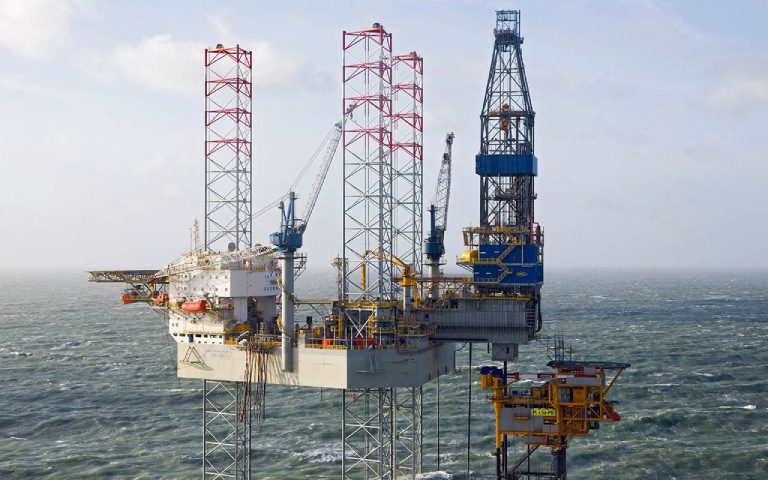(Bloomberg) — Royal Dutch Shell Plc has spent seven years and $4.5 billion, and fought off at least 50 lawsuits, for a chance to tap what is thought to be the biggest source of oil in the U.S. outside of the Gulf of Mexico.
With the last of more than 30 permit applications still pending, time is running out to get much drilling done off the coast of Alaska before having to stop for winter.
Even if the U.S. Interior Department granted the final permit this week another 14 days would be needed to get a specially designed barge to the area. That means work the company had planned to have under way in July couldn’t begin until September. Drilling has to end by Sept. 24 in the Chukchi Sea, and Oct. 31 in the Beaufort Sea — and can’t resume until July under the terms of permits it has already obtained.
“It seems to me that we are getting closer and closer to the point where they might not be able to do anything this year,” Philip Weiss, an analyst at Argus Research Co. in New York, said Aug. 17 in a telephone interview. “They’re running out of time.”
Shell, based in The Hague, is seeking to be the first company to drill in the federally controlled U.S. arctic waters in two decades. It has spent $4.5 billion to obtain drilling rights, purchase equipment and procure permits from various federal agencies in pursuit of an underwater supply of oil estimated to hold more than 20 billion barrels.
First Ship
“Our goal remains to drill and complete as many wells as time will allow this open-water drilling season,” including beginning wells that can be completed next year, Kelly op de Weegh, a Shell spokeswoman, said in an e-mail Aug. 16.
“We are in communication with a number of agencies and are considering our options,” she said. “We will make the most of the time we have this season.”
The company dispatched the first of its two drilling ships, Kulluk, from Dutch Harbor, Alaska, to the drilling site in the Beaufort Sea today and said the trip will take about two weeks. Two other vessels are already on the drilling site, op de Weegh said in an e-mail today.
Shell’s drilling season is limited by the harsh Arctic climate. The Sept. 24 and Oct. 31 deadlines imposed by the Interior Department are based on historic patterns of ice formation and include time to clean up any spills before winter conditions make such work nearly impossible.
High Stakes
RBC Capital Markets downgraded Shell to “sector perform” from “top pick” last month, saying the company’s growth projects, including the Alaskan oil exploration and investments in liquefied natural-gas projects in Australia, are “perceived as higher cost, higher risk, less-visible reward,” according to a July 18 note to investors.
“The stakes are so high, and the upside of producing oil from the Arctic is potentially so high, that they may actually go ahead and decide to do as much as they can this year,” Tad Patzek, professor and chairman of the Petroleum & Geosystems Engineering Department at the University of Texas at Austin, said in an interview. “I think they’re going to just put a flag, so to speak, on the sea floor.”
An Arctic well takes two weeks to a month to drill, according to Patzek. It’s a costly endeavor: Shell’s expenses include leasing the Noble Discoverer drilling rig from Noble Corp. for $240,000 a day, along with about two dozen other vessels, according to the two companies.
Two Wells
“It would be better off just saving that money and putting it toward next year,” said Jackie Savitz, senior campaign director at the Washington-based environmental group Oceana that opposes the drilling. “But then, they could also say — ‘But, you know what, let’s just go ahead and do it so we can kind of, you know, sort of smooth the way for what we want to do next year.’”
Shell’s exploration plans originally called for 10 wells — five this year and five next — with work beginning last month. Ice that remained longer than usual and Coast Guard concerns with the spill-containment barge, the Arctic Challenger, delayed the start and caused Shell to cut the number of wells planned for this year from five to two.
Arctic Challenger is still in Bellingham, Washington. It was designed to help contain an oil spill, as required by new safety requirements imposed by the U.S. after the 2010 BP Plc oil spill in the Gulf of Mexico.
The Coast Guard is waiting for Shell to fix deficiencies found in the safety systems, Jamie Frederick, a Coast Guard spokesman, said in a phone interview on Aug. 17.
Early 1990s
Nobody has drilled in federal offshore areas north of Alaska since the early 1990s, when lower oil prices reduced potential profits. Once the Coast Guard approves the barge, Shell will have to demonstrate its oil-containment system in open water, op de Weegh said. A similar test on another device earlier this year took only a day, and it should be the last step before obtaining the final permit, she said.
“It’s a necessity for Shell to be able to demonstrate that they have met regulatory requirements,” Interior Secretary Ken Salazar told reporters on Aug. 13 in Anchorage. If the company fails, “there won’t be Shell exploration” this year, he said.
-By Katarzyna Klimasinska. Copyright 2012 Bloomberg

 Join The Club
Join The Club



![What’s The Deal With Shell’s Arctic Drilling? [UPDATE]](https://gcaptain.com/wp-content/uploads/2012/08/391561_10151107833233886_1642272077_n.jpeg)







